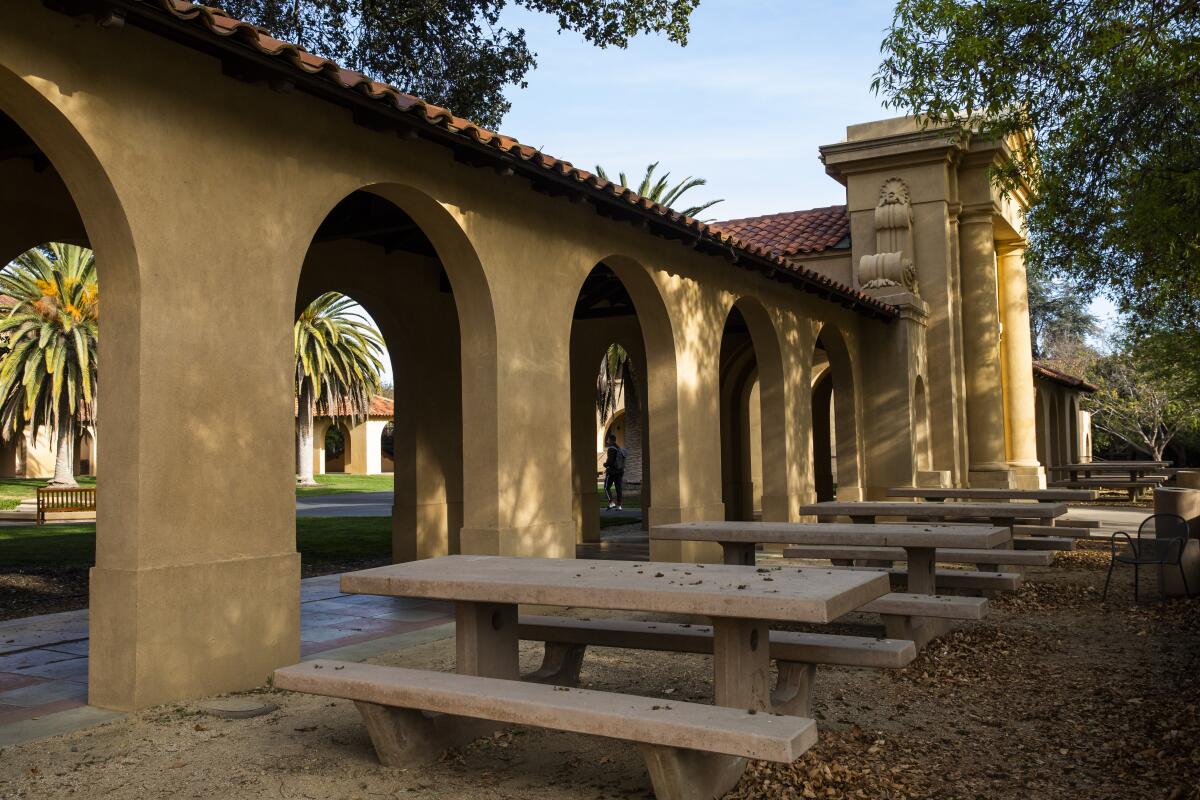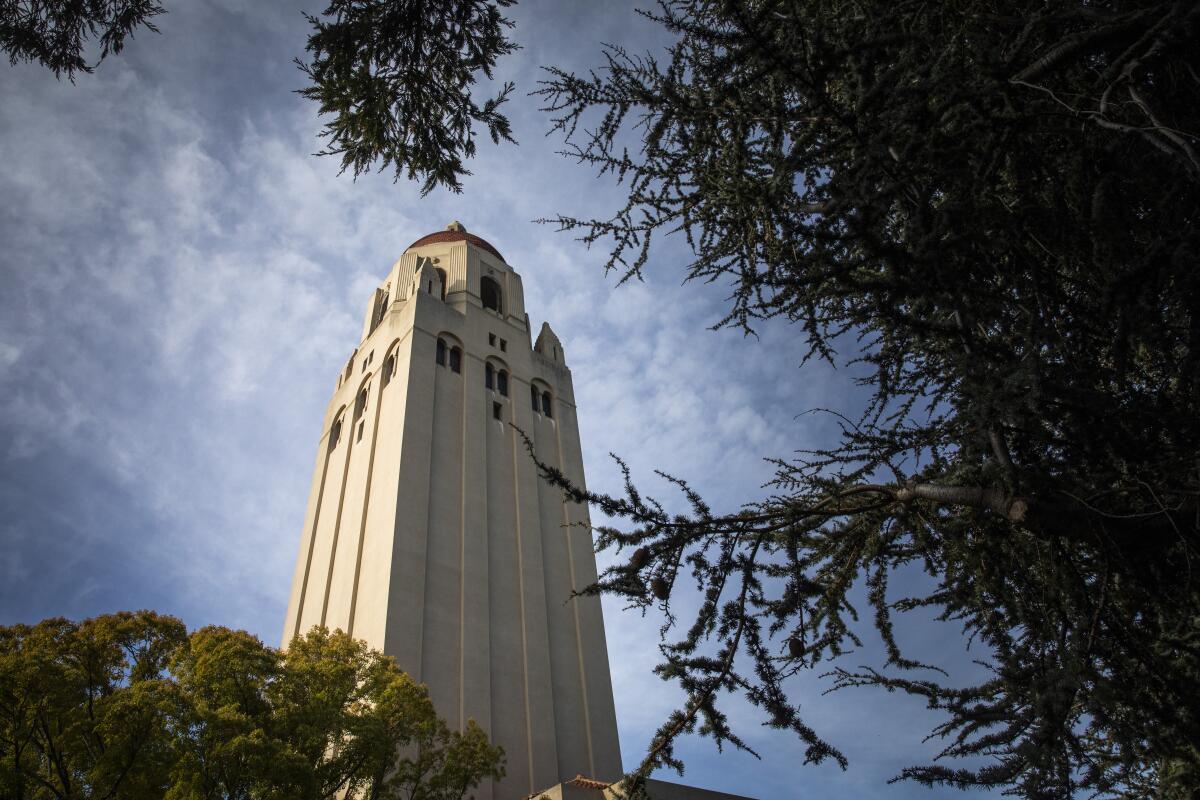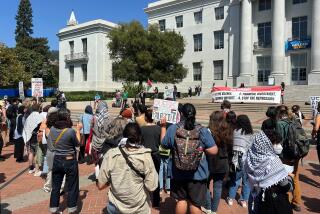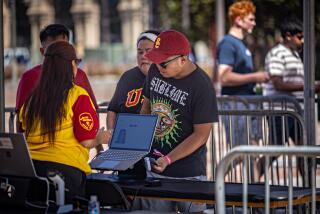Coronavirus has forced thousands at Stanford and other private colleges to evacuate

- Share via
PALO ALTO — At 5 p.m. Wednesday, hundreds of students were forced to leave Stanford University, an effort by one of California’s most prestigious academic institutions to stem the coronavirus outbreak and adhere to Santa Clara County rules banning gatherings of more than 50 people.
Universities across California and the United States are taking similar precautions, creating hardships for students who are homeless, don’t have safe places to shelter or have immunocompromised relatives at home.
On Tuesday evening, the University of San Diego told residential students to move out of their dorms by late Wednesday, four days ahead of schedule. “To date, only 1,100 of our 2,600 students in our residence halls have relocated,” the private Catholic university said in a message that evening to the college community.
On Wednesday, only a few students were spotted on campus at Stanford. Tresidder Memorial Union was devoid of students, as was White Memorial Plaza, where hundreds of students would typically be riding their bicycles, walking in small groups or lolling under trees to read and study.
“It’s eerily quiet,” said Tiffany Cartagena, a junior from Gainesville, Fla. “It’s depressing.”
Standing in front of Norcliffe Hall, she and her boyfriend, Jonah Price, stopped to chat with a visitor while packing Price’s car. Cartagena said she had taken everything out of her dorm room, assuming she won’t be returning this spring. The news of a forced departure came suddenly and, students say, confusingly.
“They’ve said we’ll come back on May 15,” Cartagena said. “But the way things are looking, I’m not sure I believe it.”
Across the state, colleges and universities are grappling with whether to let students stay in campus housing or send them home.
Campus officials want to downsize their densely populated dorms and classrooms to protect against the risk of spreading the infectious disease. That is especially true in Santa Clara County, where six people have died of the virus, with 175 confirmed infections, as of Wednesday evening.
But as they are evacuated, some students may lack access to shelter, food, Wi-Fi or a safe place to call home.
The University of California’s nine undergraduate campuses plan to keep dormitories and dining facilities open to students who need them — although they are urging those who can to safely go home.
UC Merced, where two-thirds of its 8,800 students are from low-income families, has told all students who need to stay that they are welcome to do so, and it plans to continue its basic needs services, such as food and rent assistance. The campus also has emergency funds available for needy students — those who lose jobs, for instance — and has offered loaner laptops and wireless hot spots to help with online learning.
UCLA also will continue to serve its students on campus as needed. But all dining halls and quick-service restaurants have become to-go operations with meals served in takeout containers.
“We recognize that university housing could be a student’s permanent home, and not all students can leave,” campus spokesman Ricardo Vazquez said.
Some private institutions such as Stanford and Pomona College have responded somewhat differently, requiring students to leave campus unless their petition or application is approved.
Though student protests over the issue have roiled Pomona, the process has unfolded more smoothly at neighboring Claremont McKenna College, a fellow member of the five undergraduate Claremont Colleges.
Among 1,184 Claremont McKenna students living in campus housing, about 200 petitioned to stay and about 85 received approval to do so. That included all international student applicants, who face potential health risks and visa problems if they leave the country, said Dianna Graves, assistant vice president and dean of students.
Graves said the top concern of those who petitioned to stay involved technology. The college was able to meet those needs by providing enhanced internet and data plans, loaner laptops and iPads, connections via virtual private network and other services, Graves said.
At Pepperdine University in Malibu, about 1,000 students requested permission to continue living on campus. About 200 will do so, more than half of them international students. University officials were able to help the other students get home safely by providing financial support from donor gifts for flights and gas — or a safe place to live temporarily, said Connie Horton, vice president for student affairs.
At Pomona, school officials said in a statement that they are “working with students around the clock to help find housing and travel options for the move off-campus.”
The school says it will continue to pay student employees, help cover travel costs, offer Wi-Fi hot spots and laptops, and provide room and board refunds for students, moves that other private colleges have made nationwide.
But some say those efforts fall short of addressing the outbreak response’s effect on students who must return home and come from poverty, abuse or other risky situations. And they say school officials have not offered them clear communication and guidance.
Student advocates with the group FLI Scholars, the acronym for first-generation and low-income students at Pomona College, surveyed 135 students who petitioned to stay. The self-reported data indicate that 70% were denied, they said. School officials did not respond to questions about how many students had applied to stay and how many were accepted or rejected.
In their letter to students, officials said that they would “not be able to accommodate every student who requests to stay on campus while also doing our part to limit the spread of the virus.”
For their part, Stanford University officials declined to provide information on the number of students staying or the number of those who applied to stay but were rejected.

Ernest Miranda, senior director of media relations at Stanford, said university officials regretted being unable to accommodate everyone and are now “working with students to address their particular needs and concerns.”
He noted accommodations were made primarily for international students who could not return home because of travel restrictions and students who faced severe hardships, such as homelessness, food insecurity or abuse, if they returned home.
For senior Kiara Dunbar, going home creates problems not just for her but also for her family.
“My campus job is my only source of income at the moment,” she wrote in an email to the university. “Without it, I become a financial burden…. I am on full financial aid for a reason.”
In addition, according to many students, Stanford will be readjusting student financial aid, arguing that costs are reduced when students live off campus.
“When I’m here (at school), I have full aid,” tweeted Kelsie Wysong, a senior at Stanford. “When I go home, I won’t have a job like I did in high school to offset the costs of me living at home. This creates a financial burden to my family.”
Stanford’s Miranda said the university is “adjusting spring quarter financial aid packages to reflect reduced housing expenses” for students not living on campus.
Groups such as the student-organized Stanford Mutual Aid and Stanford student government have jumped in to help students, providing them with grocery and Uber gift cards, said William Shan, a sophomore and a member of the newly sprung Stanford Mutual Aid.
Shan’s group has begun a matching program allowing alumni, faculty and Stanford-area community members to provide support for students in need. It offers students financial aid, a couch to live on, a spare bedroom or even a suitcase, said Shan, who is at home, quarantined in his bedroom in San Jose.
So far, the groups have collectively provided more than $100,000 to help students in need, Shan said.
“We’re really in a position of privilege,” said Jeffrey Rodriguez, a senior from Lakeside, who works six jobs to support himself and his family. He said he recognizes he and his fellow students are in a unique position.
At Pomona College, Marie Tano, 21, thought she had found a sanctuary when she arrived to study from a small town in Georgia. For the first time, she didn’t have to worry about money, her food was taken care of, and she had access to healthcare, therapy and support to do well in school.
Yet Pomona rejected her petition to stay on campus, which she hopes the school will reconsider. For now, she’s making plans to stay with alumni in Los Angeles.
Going home to Georgia is not an option, she said. Her father is older, and she worries about making him sick. She also has a history of health problems, and her doctors and therapists are near campus. She questions how a school with significant resources cannot accommodate more students.
“The school has made me feel like a burden,” she said. “This is a school with a $2-billion endowment.”
More to Read
Sign up for Essential California
The most important California stories and recommendations in your inbox every morning.
You may occasionally receive promotional content from the Los Angeles Times.
















